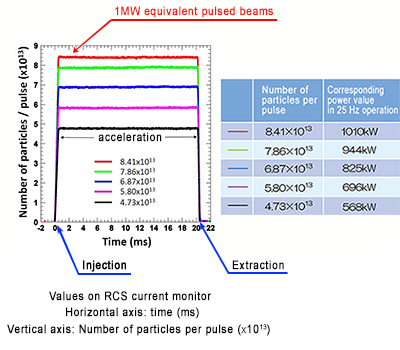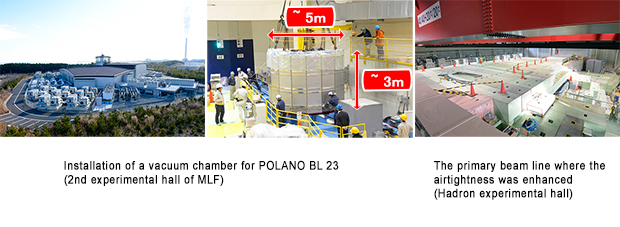| Ā° J-PARC News - January 2015 (Issue #117) |
| ĀúSuccess in Transporting 1-MW Equivalent Beam to the MLF Target by 3-GeV Synchrotron |
|---|
| We are happy to announce that we reached to the big milestone of the J-PARC project. On January 10, the acceleration of pulsed proton beams to 1-MW equivalent, the designed value, was successfully demonstrated at the J-PARCĀfs second accelerator, the 3-GeV synchrotron (RCS) . We were also succeeded in extracting the beams without any significant beam loss. |
| Further beam studies will be carried out in order to increase the proton beam power in stages and eventually to achieve the stable 1MW beam supply to users. |
 
 * Click here to enlarge. * Click here to enlarge. |
  
 * Click here to enlarge. * Click here to enlarge. |
| |
| ĀúNew Non-Destructive Element Analysis Method Using Neutrons |
|---|
| Working with the "BL4:ANNRI" accurate neutron-nucleus reaction measurement instrument of J-PARC's Materials and Life Science Experimental Facility (MLF) , Senior Scientist Yosuke Toh and his colleagues at the Nuclear Science and Engineering Center of the JAEA, and Professor Mitsuru Ebihara of the Graduate School of Science and Engineering, Tokyo Metropolitan University, have developed a new element analysis method combining two existing non-destructive analysis techniques using neutrons (prompt gamma ray analysis*1 and neutron resonance absorption analysis*2 ) . This new analysis method enables accurate analysis of elements which have previously been difficult to analyze using individual techniques. Non-destructive analysis methods enable inspection without destroying the sample, and thus are very effective for analyzing valuable samples such as radioactive material samples or specimens brought home by the Hayabusa 2 asteroid explorer. This method is expected to help advance research in a variety of fields. (Press Release, December 22, 2014) |
| *1 Prompt gamma ray analysis : An element analysis method in which the sample is irradiated with a neutron beam, and the energies and numbers of emitted gamma rays are measured when neutrons are absorbed by the sample |
| *2 Neutron resonance absorption analysis : An element analysis method using the fact that atomic nuclei absorb neutrons with certain specific energies (characteristic of each element) extremely well. |

 * Click here to enlarge. * Click here to enlarge. |
| |
| Ā£to Page Top |
| |
|
| The operation of J-PARC has been suspened. Resumption of the operation will be informed as soon as possible. |
| (1) At the Materials and Life Science Experimental Facility, the vacuum chamber for the BL23 neutron instrument POLANO was carried in and installed on February 15. the 15th. (2) At the Hadron Experimental Facility, work to improve airtightness of the primary beamline room was completed in early January. |

 * Click here to enlarge. * Click here to enlarge. |
| |
| Ā£to Page Top |
| |
| ĀúOver 50,000 Visitors Have Inspected or Toured J-PARC |
|---|
| The number of visitors who have come to inspect or tour J-PARC surpassed 10,000 in the two years from April 2005 (when statistical research began) to August 2007, and in December of last year, the number reached 50,000 after roughly 10 years. |
| |
| |
| Ā£to Page Top |
| |
|
| ĀúThe 14th Japan - Korea Meeting on Neutron Science (January 7-9) |
|---|
| This meeting was organized by the J-PARC Center, and held at the Ibaraki Quantum Beam Research Center with the joint sponsorship of CROSS, the KEK Institute of Materials Structure Science, the Institute for Chemical Research of Kyoto University, the Institute for Solid State Physics of the University of Tokyo, the Korean Neutron Beam User's Association, the Center for Korean J-PARC Users (CKor J-PARC) and others. This is an international scientific meeting which discusses instruments for neutron scattering experiments and research utilizing neutrons, while incorporating the perspective of research collaboration between the countries of Japan and Korea. Since it was first held in Korea in the year 2000, it has been held every year, while alternating the hosting country between Korea and Japan. This was the 14th meeting, and it was held at J-PARC for the first time. There were 29 participants from Korea, and 50 participants from Japan (including Korean researchers currently residing in Japan) . The meeting began with a welcome party on the first day, and on the 8th the actual research meeting was launched with a welcome address by Yujiro Ikeda, Director of the J-PARC Center. Over two days, there were a total of 56 oral and poster presentations. Also, on the 8th there was a tour of JRR-3 and the Materials and Life Science Experimental Facility (MLF). At the business meeting for key concerned parties held at the same time, there were discussions of specific methods for promoting future Korea-Japan cooperation in the neutron field, including promoting the use of J-PARC by the Korean side through active utilization of CKor J-PARC. The next meeting is scheduled to be held in Korea around January of 2016. |

 * Click here to enlarge. * Click here to enlarge. |
| |
| Ā£to Page Top |
| |
| ĀúSAT Technology Showcase 2015 (January 21) |
|---|
| This event was held at the Tsukuba International Congress Center by the Science Academy of Tsukuba (SAT), with the participation of researchers and engineers in a wide range of fields, and interested parties from the government and companies. The aim was to provide a venue for networking, exchange of information and other beneficial interaction. In the exhibition area, the J-PARC Center showcased its facilities and related topics using models, panels, and PR DVDs. |
| ĀúFlower Arrangement Class for Foreign Researchers (January 14) |
|---|
| On January 14, a flower arrangement class was held in the lobby of the Advanced Science Research Center (ASRC) on the grounds of the Japan Atomic Energy Agency (JAEA), and the participants were eight foreign researchers, including both J-PARC users and staff working for the JAEA. The participants learned the basics from members of the flower arrangement clubs of the JAEA and Tokai-mura International Center, and using flowers of their own choice completed flower arrangements full of individuality. When the participants finished their creations, they made other works using left over flowers, and everyone fully enjoyed their first experience of flower arrangement. The finished works were displayed in the ASRC lobby on January 15-16 as part of a cultural festival at the Nuclear Science Research Institute, and delighted the eyes of the staff and other visitors to the building. |
©2015 J-PARC Center. All rights reserved.
|
|
|